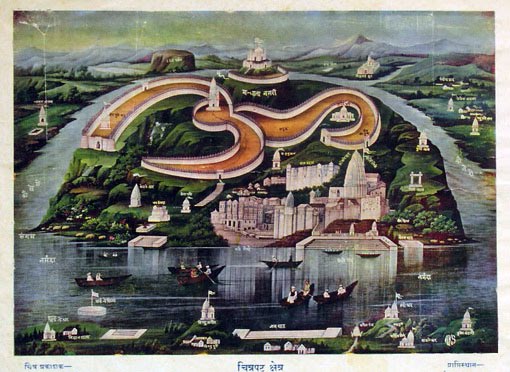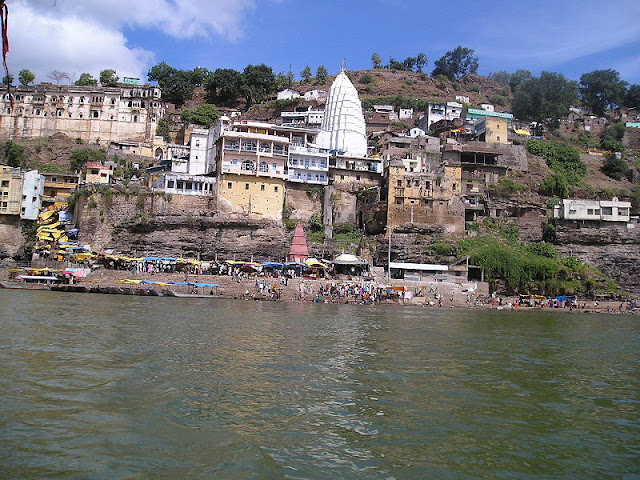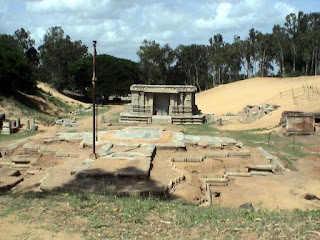Showing posts with label Shiva Temple. Show all posts
Showing posts with label Shiva Temple. Show all posts
Tuesday, October 12, 2010
Friday, September 3, 2010
In the land of the ‘Om’ - Omkareshwar Jyotirlinga
There are two main temples at Omkareshwar, one on the mainland and one on the island. The island temple is credited to Mandhata, an ancestor of Rama, who installed the lingam and built the temple. While most consider this one to be the Jyotirling, the place abounds in myth and legend. According to one, this lingam is believed to have split into two and installed itself on the other bank too. According to others, it is the temple of Mamleshwar (also called Amaleshwar or Amareshwar) on the mainland which is older and the real Jyotirling.
Mamleshwar the Jyotirling:
While the island temple has received much attention in the past and has been renovated recently, the Mamleshwar temple certainly looks much older and more beautiful too. The Mamleshwar temple is also more endearing thanks to the absence of the pandas (priests) who are the most prominent feature of the Omkar Mandhata temple on the island. We visited the Mamleshwar temple at night before the final aarti was performed, and had to literally hunt out a priest to perform abhishek to the lord, and the one we finally found was so thrilled by all the items we had brought for the puja that he happily did the elaborate puja with a smile on his face and asked for money only when we were done.Omkar Mandhata:
For a long time, the only way to approach the island was by boat. Now, there are two bridges, one connecting the boat landing area to the Omkar Mandhata temple, the other connecting the two temples — Omkareshwar and Mamleshwar. No vehicles are allowed on the island, so both are only foot bridges. The Narmada which once flowed fast and furious along this stretch is now a tame river, thanks to a dam mired in controversy, of which one gets a wonderful view from the bridge.
The entire island is a hilly area, and it is these hills which give it the shape of the Om. Just a few steps take us to the temple, which is visible from quite a distance.
 |
| Chitrapat Kshetra |
 |
| Omkareshwar |
Omkareshwar Parikrama:
While it is for the temples that most pilgrims visit Omkareshwar, the most interesting thing about the island is the island itself. With its unique shape, the island itself has been venerated, and over centuries, scores of temples have been built on it. The ancients not just built the temples, but also made a path so that one could visit all the temples while circumambulating the entire island. This is called the Omkareshwar Parikrama, and has been recently revived by MP Tourism.
There are many places of interest along the path. The first is the sangam or confluence of the two tributaries of the Narmada. This is, for a change, clean and perfect for a bath. The clear water with rounded pebbles forming the river bed invites us to sink our feet into it and enjoy a relaxed dip, while the more devout pilgrims (few, at the best of times, since it is almost an hour’s walk from the bridge) offer prayers.
 |
| Temple in India |
Then there is the Gori Somnath Mandir, an ancient temple where the lingam is a huge one, jet black in colour. Legend tells us that this lingam was once pure white, and that one could see his past life just by standing in front of it. Then came Aurangzeb, and as soon as he appeared in front of the lingam, it turned black! This is one of the few temples in the area still intact to a large extent. Though many of the beautiful sculptures have fallen down, it still stands tall and proud among the ruins of others which have not been as fortunate!
As we climb down the final steps which lead us to the end of the Parikrama, our aching legs yearn for a rest, but we feel fresh inside, and can’t help thinking that we arrived at Omkareshwar to see one of the Jyotirlings, and were appalled with the rampant commercialisation, but returned with so much more, an inner peace that comes from a truly spiritual experience!
How to reach
Omkareshwar is situated about 65 kms from Indore and 256 kms from Bhopal. The road from Indore takes us through the mighty Satpura ranges, and winds its way along the Ghats before opening up into a plain covered with cotton fields and irrigated by the Narmada. The journey from Indore to Ujjain takes a little more than an hour by car and about one-and-a-half hours by bus.
There are plenty of buses available on this route, both, those run by the MPRTDC as well as private ones. They can certainly not be classified as luxury, but they are comfortable and adequate for the short journey. A car hire for the one way trip costs about Rs 1200.
 |
| Direction to Omkareshwar |
There are plenty of buses available on this route, both, those run by the MPRTDC as well as private ones. They can certainly not be classified as luxury, but they are comfortable and adequate for the short journey. A car hire for the one way trip costs about Rs 1200.
Tuesday, June 22, 2010
Unearth the Secrets of Talakadu
It is the classical Indian story . A tale told by gods and demons, filled with kings and queens, replete with curses and boons. There is a little bit of history here, blended with some geology and topped with legends and myths. Set on the banks of the River Cauvery in Karnataka, this saga dates back to the 4th century and has certain intriguing elements, defying the very laws of nature.
 |
| Talakadu temple |
We were rather unprepared for this. At the first glance, it was just a prosaic picnic spot, overcrowded with swarms of loud local tourists and besieged by persistent guides. Stalls selling local fares were protruding in every corner. We made our way towards the river bed, where the Cauvery flowed at her own pace. It presented an unusual, yet a stark picture. There were huge mounds of sand by the banks of the river, like a beach. With a canopy of tall eucalyptus trees spread out from the sand, it felt like being in the middle of a forest. The dense shrubbery, some lively birds and monkeys dangling between the branches completed the picture.
The mounds of sand were everywhere, like small hillocks, some as high as even 15 meters. It was a steep climb, as the feet sank in with each step. It was an inexplicable sight; nobody could fathom where the heaps of sand came from. The fertile soils of the Cauvery basin seemed to have become fine particles of soft sand by sheer magic. While the answer may be with a geologist, my local guide narrates this legend.
The mounds of sand were everywhere, like small hillocks, some as high as even 15 meters. It was a steep climb, as the feet sank in with each step. It was an inexplicable sight; nobody could fathom where the heaps of sand came from. The fertile soils of the Cauvery basin seemed to have become fine particles of soft sand by sheer magic. While the answer may be with a geologist, my local guide narrates this legend.
The curse of Talakadu
 |
| Talakadu |
The story moves from being a mere myth to some startling historic discoveries as well. Recent excavations have unearthed temples from these mounds of sand and each dynasty has left their architectural stamp on them.. My guide points out that 30 such temples are still buried underneath the sand dunes as we climb our way to the excavated areas
Unearthed - spirituality under the sands
 |
| Panchlingas |
Talakadu is famous for the Panchalingas – the temples dedicated to Lord Shiva called Pathaleshwara, Maruleshwara, Arkeshwara, Vaidyanatheeshwara and Mallikarjuna.Of these, the first two are the oldest, built by the Ganga kings. The locals here say that the Shivalinga in the former is said to change color according to the time of day – from red in the morning to black in the afternoon and white in the night. To us though, in the cool afternoon, it was simply black.
We continued our spiritual quest and reached the Vaidyanatheeshwara temple, the largest of them all, which was built by the Chola rulers. All these temples are neatly thatched and embedded in pits as we climbed down to visit them. Remnants of the bygone era were seen in some scattered stones, broken pillars, an ancient well and even some idols. The Pancha Linga festival is celebrated with much fanfare once in 12 years during the Kartika season, where the temples are allowed for worshipping. The last festival happened in 1993 and the next scheduled late this year. The lost and forgotten township sees throngs of devotees only during this period, while at the rest of times, it remains a desolate spot, with a few picnickers.
We continued our spiritual quest and reached the Vaidyanatheeshwara temple, the largest of them all, which was built by the Chola rulers. All these temples are neatly thatched and embedded in pits as we climbed down to visit them. Remnants of the bygone era were seen in some scattered stones, broken pillars, an ancient well and even some idols. The Pancha Linga festival is celebrated with much fanfare once in 12 years during the Kartika season, where the temples are allowed for worshipping. The last festival happened in 1993 and the next scheduled late this year. The lost and forgotten township sees throngs of devotees only during this period, while at the rest of times, it remains a desolate spot, with a few picnickers.
Tala and Kadu - More Stories...
 |
| Temple |
 |
| Temple at Talakadu |
Excavations, they say have unearthed a 12 feet tall stone mandapa along with remnants of Garuda kamba. Work by archaeologists is still in progress here, as we stroll among the many stones, which my guide claims are ‘originals. It looked like each piece of stone was being numbered and the mantapas were being rebuilt to recreate the splendour of the past.
We had walked for more than a couple of hours, deeply engrossed in the continuous banter of our guide. Our feet caved in many a time, as we scaled the steep sand dunes. In the last two hours, we had traveled back to several centuries. We paused for a moment, taking in the sight. The silence was overwhelming. The voices of the past were buried under the layers of sand. We sat there, trying to build castles, but the wings gently swept them down. This, we realized was the destiny of Talakadu -the confluence of the historic and the holy spirit, where myths and legends merged, but were all completely swept away by the blasts from the past.
Getting There
Talakadu is just three hours by road from Bangalore, enroute to Mysore. It is about 130 kms kms from Bangalore, which is the closest airport. You could drive down from the Kanakpura Road or take the good old Mysore Road upto Maddur, past Mallavalli and proceed on the road towards Kollegal. About some 5 kms before the detour for Sivanasamudram Falls, there are sign boards indicating Talakadu, 22 kms to the right. The road is bad in patches and very often, it is long and winding, without any landmarks or signboards.
Subscribe to:
Posts (Atom)


